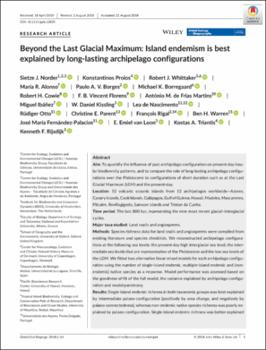Beyond the Last Glacial Maximum: Island endemism is best explained by long‐lasting archipelago configurations
Author
Norder, Sietze J.; Proios, Konstantinos; Whittaker, Robert J.; Alonso, María R.; Borges, Paulo A. V.; Borregaard, Michael K.; Cowie, Robert H.; Florens, F. B. Vincent; Frias Martins, António M. de; Ibáñez, Miguel; Kissling, W. Daniel; Nascimento Reyes, Lea de ; Otto, Rüdiger; Parent, Christine E.; Rigal, François; Warren, Ben H.; Fernández-Palacios, José María
; Otto, Rüdiger; Parent, Christine E.; Rigal, François; Warren, Ben H.; Fernández-Palacios, José María ; Loon, E. Emiel van; Triantis, Kostas A.; Rijsdijk, Kenneth F.
; Loon, E. Emiel van; Triantis, Kostas A.; Rijsdijk, Kenneth F.
Date
2018Abstract
Aim: To quantify the influence of past archipelago configuration on present‐day insular
biodiversity patterns, and to compare the role of long‐lasting archipelago configurations
over the Pleistocene to configurations of short duration such as at the Last
Glacial Maximum (LGM) and the present-day.
Location: 53 volcanic oceanic islands from 12 archipelagos worldwide—Azores,
Canary Islands, Cook Islands, Galápagos, Gulf of Guinea, Hawaii, Madeira, Mascarenes,
Pitcairn, Revillagigedo, Samoan Islands and Tristan da Cunha.
Time period: The last 800 kyr, representing the nine most recent glacial–interglacial
cycles.
Major taxa studied: Land snails and angiosperms.
Methods: Species richness data for land snails and angiosperms were compiled from
existing literature and species checklists. We reconstructed archipelago configurations
at the following sea levels: the present‐day high interglacial sea level, the intermediate
sea levels that are representative of the Pleistocene and the low sea levels of
the LGM. We fitted two alternative linear mixed models for each archipelago configuration
using the number of single‐island endemic, multiple‐island endemic and (nonendemic)
native species as a response. Model performance was assessed based on
the goodness‐of‐fit of the full model, the variance explained by archipelago configuration
and model parsimony.
Results: Single‐island endemic richness in both taxonomic groups was best explained
by intermediate palaeo‐configuration (positively by area change, and negatively by
palaeo‐connectedness), whereas non‐endemic native species richness was poorly explained
by palaeo‐configuration. Single‐island endemic richness was better explained by intermediate archipelago configurations than by the archipelago configurations of
the LGM or present‐day





